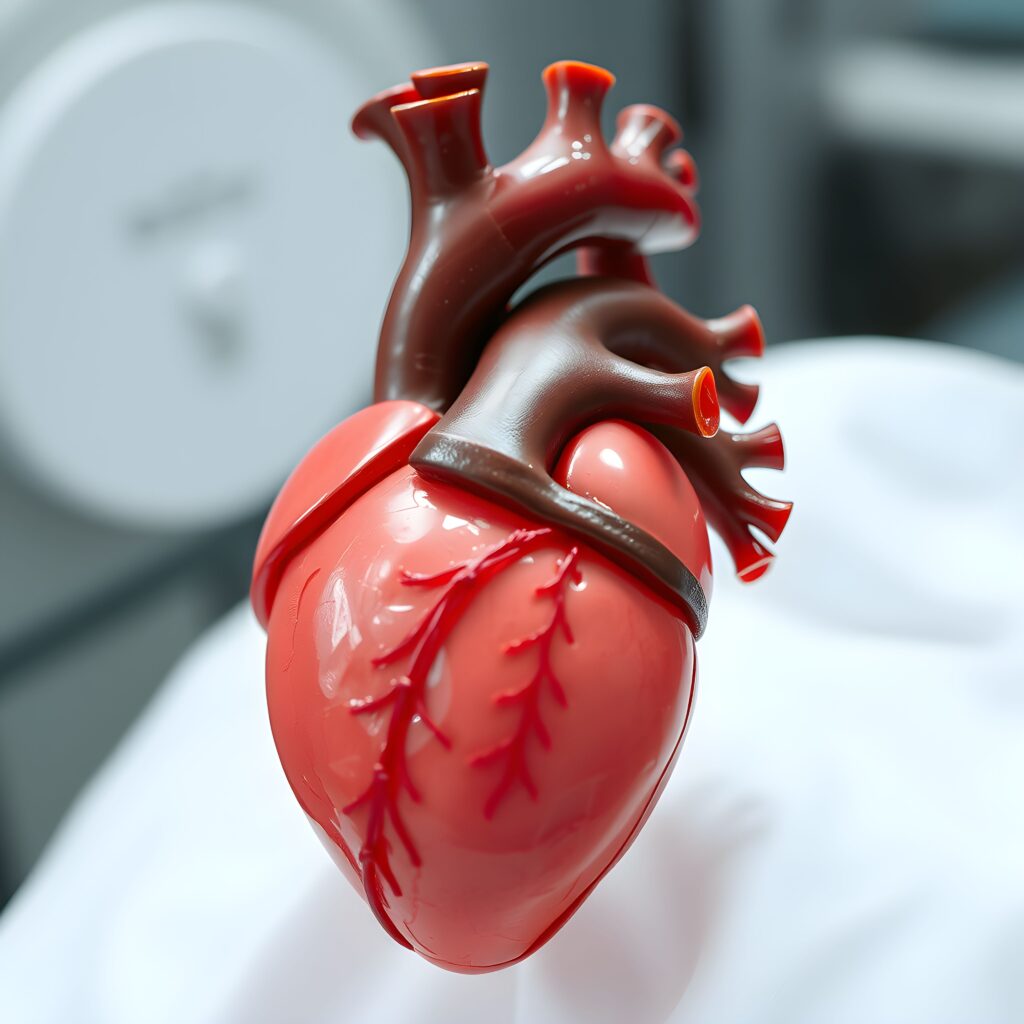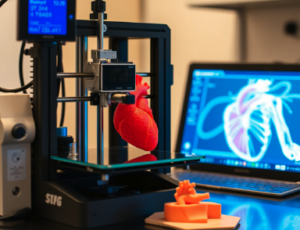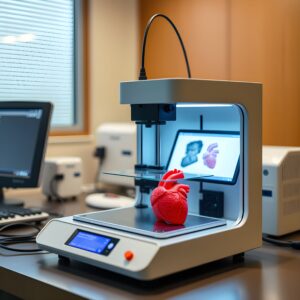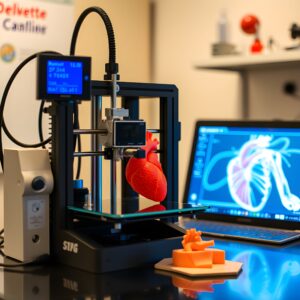3D Printing in Healthcare: Revolutionizing Patient Care

In recent years, technology has radically altered healthcare, improving patient outcomes and revolutionizing medical practices. One such groundbreaking advancement is 3D printing, which is rapidly becoming a transformative tool in healthcare. Initially used in manufacturing and design, 3D printing technology has found applications in diverse areas of medicine, from prosthetics to tissue engineering. The potential of 3D printing in healthcare lies in its ability to create personalized and precise solutions for patients, tailored to their unique anatomical and medical needs. This article will delve deeper into the different ways 3D printing is revolutionizing patient care, explore its benefits, challenges, and examine the potential for future growth within this field.
What is 3D Printing in Healthcare?
Understanding the Basics of 3D Printing
3D printing, or additive manufacturing, is a process that creates three-dimensional objects layer by layer from a digital design. Unlike traditional manufacturing techniques that involve cutting or shaping raw materials, 3D printing adds material in precise layers, gradually forming the final object. It’s a technique that has evolved significantly, allowing for complex shapes and structures to be printed with remarkable accuracy. In healthcare, 3D printing is used to produce a wide variety of medical devices, including customized prosthetics, implants, and surgical models. It has even paved the way for advances in bioprinting, which involves printing cells and tissues, opening doors for regenerative medicine.
How 3D Printing Works in Healthcare
In a medical context, 3D printing works by converting data from medical scans (such as CT scans or MRIs) into 3D digital models. Using this model, healthcare providers can print medical devices tailored to an individual patient. Whether it’s a custom prosthetic or a precise surgical guide, 3D printing ensures a higher degree of personalization, contributing to better patient care and surgical outcomes. There are various types of 3D printing methods, including Fused Deposition Modeling (FDM), Stereolithography (SLA), and Selective Laser Sintering (SLS). Each technique has distinct advantages based on the materials used, the desired product characteristics, and the level of precision needed.
Applications of 3D Printing in Healthcare
The applications of 3D printing in healthcare are vast and ever-growing. Here are some of the most notable ways this technology is making an impact:
Personalized Prosthetics and Implants
Custom Prosthetics for Enhanced Quality of Life
One of the most exciting uses of 3D printing in healthcare is the development of custom prosthetics. Traditional prosthetics are typically mass-produced, often leading to poor fits, discomfort, and limited functionality for the wearer. 3D printing addresses these issues by allowing for the creation of prosthetic limbs that are specifically tailored to the patient’s unique body measurements and needs. A key benefit of 3D-printed prosthetics is the ability to design the device for optimal fit and comfort. For instance, a prosthetic limb can be custom-shaped to match the user’s specific anatomical features, providing a more comfortable and functional experience. Additionally, 3D printing allows for the rapid production of prosthetics, reducing waiting times and improving accessibility for patients.
Cost-Effectiveness of 3D-Printed Prosthetics
Another significant advantage of 3D-printed prosthetics is their cost-effectiveness. Traditional prosthetics, especially for complex cases, can be expensive due to the labor-intensive process involved in their creation. 3D printing streamlines the production process, allowing for reduced material waste and faster manufacturing times, which leads to lower costs for both patients and healthcare providers.
Surgical Planning and Simulations
Improved Surgical Precision through 3D Modeling
3D printing has brought a major shift to preoperative planning and surgical simulations. Surgeons can now use 3D-printed models of patient-specific anatomical structures to practice complex surgeries, helping to reduce risks during the actual procedure. This can be especially beneficial for patients with unique or complicated conditions, such as rare tumors or anatomical deformities. For example, a surgeon performing a complex heart surgery can print a 3D model of the patient’s heart based on CT scan data, enabling them to visualize the surgical site more accurately. This not only enhances the surgeon’s precision but also improves the likelihood of a successful operation and a quicker recovery time for the patient.
Surgical Guides and Custom Implants
3D printing allows for the creation of custom surgical guides that help surgeons navigate complex procedures. These guides can be printed based on a patient’s specific anatomy, allowing for more precise placement of surgical instruments or implants. For example, when performing hip replacement surgery, surgeons can use 3D-printed guides to ensure the correct placement of the implant, reducing the risk of complications.
Tissue and Organ Engineering
Bioprinting: Printing Human Tissue
One of the most promising applications of 3D printing is bioprinting, the process of printing living tissues or cells. Bioprinting could potentially be used to create tissues for transplant purposes or to test new medical treatments. Although fully functional organs are not yet a reality, scientists have made significant progress in printing simpler tissues like skin, cartilage, and blood vessels. In the future, 3D-printed tissues could revolutionize organ transplantation. Researchers are working to develop bio-inks (materials used in bioprinting) that can replicate the complex structures of organs such as kidneys or livers, which may one day eliminate the need for organ donors altogether.
Tissue Engineering for Drug Testing
Another promising application of bioprinting is in the area of drug development. Using 3D-printed tissues, pharmaceutical companies can test drugs on realistic tissue models, providing more accurate results than traditional petri dish cultures. This could lead to faster development of new treatments and better outcomes for patients.
Benefits of 3D Printing in Healthcare
Cost Efficiency
The cost-saving benefits of 3D printing are significant. As mentioned earlier, the reduced manufacturing time and minimized material waste make 3D printing a more affordable solution compared to traditional manufacturing. For patients, this cost reduction translates into more accessible healthcare solutions, such as affordable custom prosthetics or implants. Healthcare providers also benefit from 3D printing by reducing the need for large inventories of standard implants or devices. Instead, 3D-printed items can be produced on demand, saving storage space and reducing overhead costs.
Faster Production and Accessibility
Speed is another key advantage of 3D printing. Traditional manufacturing methods for medical devices often require extensive lead times, especially when producing customized devices. With 3D printing, healthcare providers can produce devices and implants within hours or days, reducing waiting times and allowing for faster treatment. This is particularly crucial in emergency situations, where patients need immediate care. In remote or underdeveloped regions, 3D printing can be used to produce medical devices locally, eliminating the need for long supply chains and reducing the reliance on external manufacturers. This makes healthcare more accessible and reliable, especially in resource-limited settings.
Enhanced Patient Outcomes
Personalization is one of the key factors that contribute to better patient outcomes. 3D-printed prosthetics and implants are designed to fit the patient’s exact needs, which improves comfort and function. Personalized surgical guides and preoperative models also lead to more accurate and less invasive procedures, reducing the risk of complications and speeding up recovery.
Challenges and Limitations
While 3D printing offers numerous benefits, there are also challenges that need to be addressed. Material limitations remain a significant barrier, as not all materials used in 3D printing are suitable for use in the human body. Research is ongoing to develop more advanced materials that are biocompatible, durable, and capable of replicating the mechanical properties of natural tissues.
Regulatory hurdles also pose challenges, as medical devices and implants must undergo rigorous testing and approval processes before they can be used in patient care. The regulatory framework for 3D-printed medical devices is still evolving, and ensuring safety and efficacy remains a critical concern.
Lastly, training healthcare professionals to effectively use 3D printing technology is a challenge. Surgeons, prosthetists, and other medical professionals need specialized training to integrate 3D printing into their practice, which requires both time and investment.
Future of 3D Printing in Healthcare
The future of 3D printing in healthcare is incredibly promising. As technology continues to evolve, we can expect even more sophisticated applications, such as printing complex organs for transplantation and creating functional artificial tissues. The integration of artificial intelligence (AI) and robotics with 3D printing could further enhance precision and efficiency in medical treatments, leading to groundbreaking new capabilities.
3D printing is revolutionizing healthcare by providing personalized solutions that improve patient care, reduce costs, and enhance surgical outcomes. As the technology advances, its applications will continue to expand, transforming the healthcare landscape in ways we are only beginning to understand. The future of 3D printing in medicine is bright, with the potential to change the way we approach treatment, surgery, and even organ transplantation.
For other insights and projects, be sure to explore our Key Technologies in 3D Printing or Uses of 3D Printing




